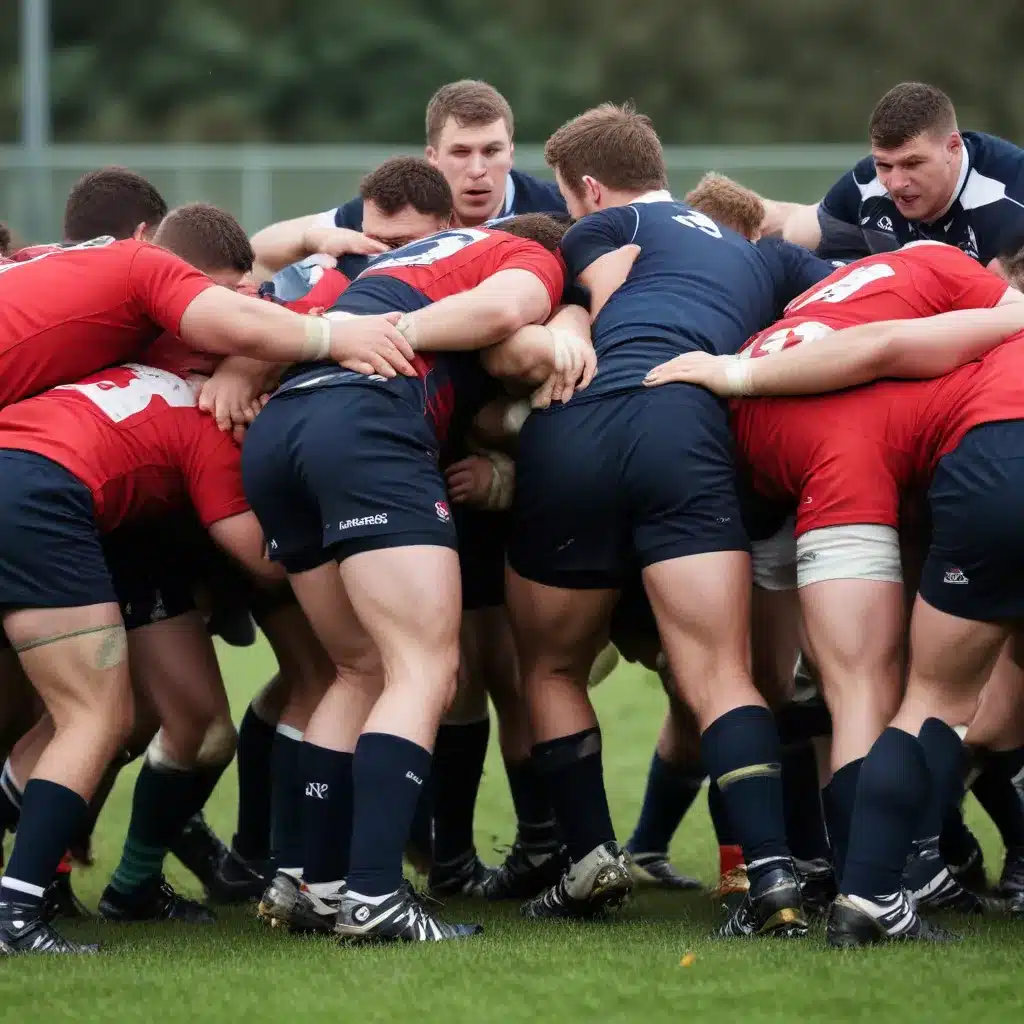
Rugby Scrum Mechanics
The foundation of a dominant rugby pack lies in the mastery of scrum mechanics. Scrum engagement, technique, and tactics are the building blocks that allow forwards to assert their will and control the set-piece.
Scrum Engagement
Effective scrum engagement begins with proper binding. Props must establish a strong, secure bind on their opposing numbers, ensuring a solid platform for the push. Foot positioning is crucial, with the lead foot slightly ahead and the back foot angled to optimize drive and momentum. Maintaining a low, balanced body shape is essential for generating maximum force.
Scrum Technique
Perfecting scrum technique takes dedicated practice and refinement. The ideal scrum body shape features a flat back, engaged core, and bent knees – allowing the pack to channel their power through the point of engagement. The drive technique is all about synchronized, explosive leg drive, transferring force from the ground up through the pack.
Scrum Tactics
Effective scrum tactics go beyond individual technique. Coordinated scrum calls, clear communication, and varied scrum setups can confuse and overwhelm the opposition. Practicing a range of scrum options, from traditional engagements to more complex set-plays, empowers the pack to adapt to any situation.
Rugby Scrum Dynamics
Developing a cohesive, well-coordinated scrum unit is paramount to achieving scrum dominance. The interplay between the forwards, their communication, and their collective discipline determines the pack’s effectiveness.
Scrum Cohesion
Aligning the pack for maximum cohesion is a constant challenge. Ensuring players maintain their assigned positions, with even weight distribution and a tightly bound platform, is essential for generating a powerful, unified shove. Regular drills and a shared understanding of roles and responsibilities build that vital unit cohesion.
Scrum Coordination
Seamless scrum coordination requires clear, concise communication. Established scrum calls, signals, and feedback loops allow the pack to anticipate and react in unison. Perfecting the timing of the engagement, drive, and finish is the hallmark of a well-oiled scrum machine.
Scrum Communication
The scrum captain plays a pivotal role in orchestrating effective scrum communication. Their ability to call the shots, provide real-time feedback, and motivate the pack is crucial. Developing a shared language, both verbal and non-verbal, empowers the forwards to execute the plan with precision.
Rugby Scrum Conditioning
Equipping the pack with the necessary physical attributes to dominate the scrum is a multi-faceted endeavor. Targeted strength, endurance, and mobility training are the cornerstones of scrum-specific conditioning.
Scrum-Specific Strength Training
Developing lower body power is paramount for scrum dominance. Exercises like squats, deadlifts, and explosive leg presses build the requisite strength and drive to overwhelm the opposition. Complementing this with core stability work ensures the pack can maintain structural integrity under immense pressure.
Scrum-Specific Endurance Training
The demands of the modern scrum require exceptional aerobic and anaerobic capacity. Interval-based training, simulating the high-intensity, intermittent nature of scrummaging, builds the pack’s ability to sustain their effort over the course of a match. Implementing scrum-specific drills and conditioning further enhances their game-day readiness.
Scrum-Specific Mobility Training
Ensuring the pack’s joints and connective tissues are supple and resilient is crucial for injury prevention and optimal performance. Dedicated mobility work, targeting the hips, ankles, and thoracic spine, equips the forwards to maintain the necessary body positions and range of motion required for dominant scrummaging.
Rugby Scrum Leadership
The scrum captain’s role extends far beyond their individual contribution. Effective leadership, coaching, and motivation are key to fostering a dominant scrum unit.
Scrum Captain Responsibilities
The scrum captain must oversee the pack’s organization, maintaining discipline and cohesion. They are responsible for coordinating the unit’s alignment, communicating the plan, and ensuring adherence to technical and tactical directives.
Scrum Unit Coaching
Refining scrum technique and tactics is an ongoing process. The scrum captain, alongside the forwards coach, must continually analyze performance, identify areas for improvement, and implement targeted training to elevate the unit’s skill level.
Scrum Unit Motivation
Cultivating a winning mentality within the scrum unit is essential. The captain must inspire their teammates, instilling a sense of pride, confidence, and determination. By fostering a culture of scrum dominance, the pack is empowered to impose their will on the opposition.
Rugby Scrum Dominance
Ultimately, scrum dominance is achieved through the seamless integration of technique, tactics, and mental fortitude. Developing a multifaceted approach to both attacking and defending the scrum allows the pack to dictate the tempo and momentum of the game.
Scrum Attacking Strategies
Mastering the scrum drive, with its explosive power and coordinated drive, is a formidable weapon. Complementing this with the ability to execute intricate scrum wheels and set-plays can bamboozle the opposition and create scoring opportunities.
Scrum Defensive Strategies
Effective scrum defense requires the pack to disrupt the opposition’s engagements, deny their momentum, and squeeze the life out of their set-piece. Developing techniques to counteract the opposition’s tactics, while maintaining discipline and structural integrity, is essential for nullifying their threat.
Scrum Gainline Dominance
Establishing scrum ascendancy is a key tactical objective. By consistently winning the gainline battle and generating positive momentum, the pack can set the tone for the rest of the match. This scrum dominance can have a profound psychological impact, demoralizing the opposition and inspiring confidence in one’s own team.
The path to scrum dominance is paved with meticulous attention to detail, unwavering discipline, and an unyielding commitment to excellence. By mastering the mechanics, dynamics, conditioning, and leadership required to forge an unbreakable pack, teams can unlock the true power of the scrum and assert their authority on the rugby field.
As the Aberdeenshire RFC strives to cement its place as a formidable force in Scottish and UK rugby, developing scrum dominance must be a central focus. By embracing the principles outlined in this comprehensive guide, the Reds can forge a pack that strikes fear into the hearts of their opponents and propels the club to new heights of success. Unlock the power of the pack, and the path to glory will be laid bare.
